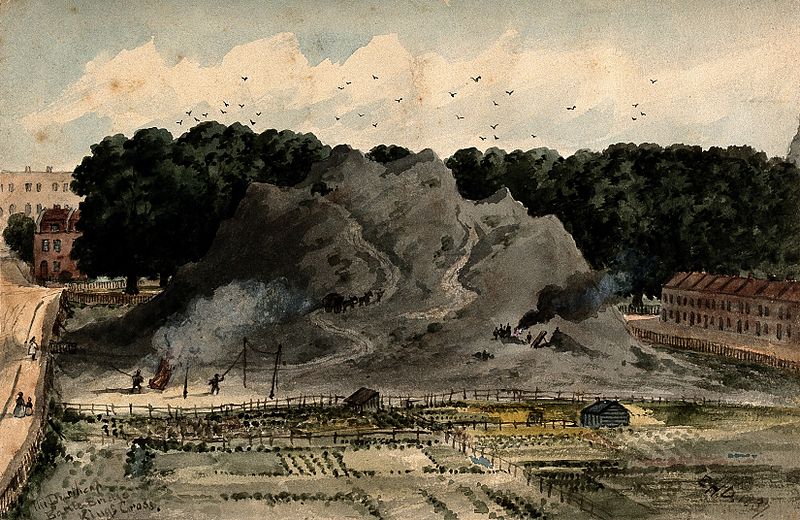Dust heap
|
This watercolour painting depicts King's Cross, London: the Great Dust Heap, next to Battle Bridge and the Smallpox Hospital by E H Dixon (1837). Notations associated with the painting describe it as a ‘View of the Great Dust Heap, King’s Cross, Battle Bridge, from the Maiden Lane (the present York Road). It was removed in 1848 to assist in rebuilding the City of Moscow, Russia.’ |
Contents |
[edit] Introduction
Dust heaps were human-made mountains of ash, cinders and combustible domestic waste or soil that accumulated around London during the 19th century. These piles of fine dust, clinker, breeze (or brieze) and other household rubbish were created by the large amounts of coal used in London from roughly 1800 to 1850. During this period, it was thought that each London household used as much as 11 tons of coal annually for domestic fires.
[edit] Early waste collection method
This form of waste management was initially instituted for practical safety purposes. It was thought that the large quantity of ash residue - if left uncollected - would block passageways and create other hazards in London.
To combat the safety issue of unmanaged household waste - which was also becoming a public eyesore - communities employed dust contractors who would be hired to collect and transport the material to the dust heaps on the outskirts of the city. For those in the dust collection market, this became a lucrative business, since the materials held varying degrees of value once separated out by labourers known as sifters or scavengers.
Domestic waste (or soil) was sold to farmers for manure. Cinders, ash, clinker and breeze were sold to brickmakers (as fuel for burning and material for making building materials; this is the origin of the terms breezeblock - or briezeblock - and cinderblock in the US). Other salvageable items (such as discarded pans and pottery) were also recovered and set aside for possible sale or reuse.
[edit] The Great Dust Heap of King’s Cross
Dust heaps were a fixture in London during Victorian times. In Our Mutual Friend by Charles Dickens, dust heaps were the source of wealth for Nicodemus (Noddy) Boffin, a lowly clerk who inherits several dust heaps from his employer and becomes The Golden Dustman. These vast piles were extremely valuable, but when it became necessary to address public sanitation issues in the 1850s, the phase out process began.
One of the most valuable and extensive of these sites in London was the Great Dust Heap. In 1848, this vast mountain was removed to make way for King’s Cross Station (which was part of the newly commissioned Great Northern Railway).
According to Vic Keegan’s Lost London 109: The Great Dust Heap, “Contemporary accounts – including W J Pinks’s venerable survey of Clerkenwell – report that the dust heap was sold – wait for it – to the government of Russia to help the re-building of Moscow after the war with Napoleon for an estimated price of £20,000.”
[edit] Related articles on Designing Buildings
- A heritage partnership agreement for King's Cross Station.
- Blockwork.
- Civil Engineering during the Industrial Revolution in Britain.
- Clinker in construction.
- Coal ash.
- Environmental engineering.
- King's Cross Station Redevelopment.
- Miasma theory.
- Three pieces of infrastructure that have saved lives.
- Waste management - explained.
[edit] External resources
- Victor Keegan, On London, Lost London 109: The Great Dust Heap.
IHBC NewsBlog
IHBC Membership Journal Context - Latest Issue on 'Hadrian's Wall' Published
The issue includes takes on the wall 'end-to-end' including 'the man who saved it'.
Heritage Building Retrofit Toolkit developed by City of London and Purcell
The toolkit is designed to provide clear and actionable guidance for owners, occupiers and caretakers of historic and listed buildings.
70 countries sign Declaration de Chaillot at Buildings & Climate Global Forum
The declaration is a foundational document enabling progress towards a ‘rapid, fair, and effective transition of the buildings sector’
Bookings open for IHBC Annual School 12-15 June 2024
Theme: Place and Building Care - Finance, Policy and People in Conservation Practice
Rare Sliding Canal Bridge in the UK gets a Major Update
A moveable rail bridge over the Stainforth and Keadby Canal in the Midlands in England has been completely overhauled.
'Restoration and Renewal: Developing the strategic case' Published
The House of Commons Library has published the research briefing, outlining the different options for the Palace of Westminster.
Brum’s Broad Street skyscraper plans approved with unusual rule for residents
A report by a council officer says that the development would provide for a mix of accommodation in a ‘high quality, secure environment...
English Housing Survey 2022 to 2023
Initial findings from the English Housing Survey 2022 to 2023 have been published.
Audit Wales research report: Sustainable development?
A new report from Audit Wales examines how Welsh Councils are supporting repurposing and regeneration of vacant properties and brownfield sites.
New Guidance Launched on ‘Understanding Special Historic Interest in Listing’
Historic England (HE) has published this guidance to help people better understand special historic interest, one of the two main criteria used to decide whether a building can be listed or not.


















